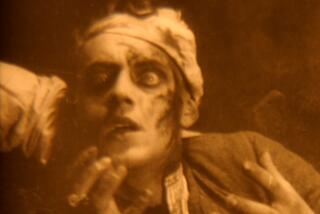History Reprinted : Museums: Actors portray historic figures whose lives were influenced by the evolution of the printing process. Antique printing equipment will be on display and in working order.
- Share via
The wheels and dials on an odd-looking contraption on the wall spin and start to whir and clank. Meanwhile, lights flash and your guide, an eccentric professor, says this is a time machine and that he will lead you on a journey to visit six historical figures.
And before you know it, actors assuming the personas of Benjamin Franklin, Mark Twain and Johann Gutenberg are regaling you with stories about themselves and the important role printing has played in modern civilization.
This theatrical sleight of hand is a live performance scheduled for introduction Friday at the International Museum of Graphic Communications, 8469 Kass Drive, Buena Park. And it is just one way this unusual working museum will be able to draw its visitors into the excitement of the printing process.
Franklin, who became a printer’s apprentice at age 12, will talk about his life and the role that printing played in Colonial and Revolutionary America.
Gutenberg is credited with the invention of movable type in Europe. He will sing of the financial troubles that befell him in 15th-Century Germany before he could even complete the printing of his famed Gutenberg Bible.
T’sai Lun will set the scene for AD 105, when he announced the invention of paper to Chinese Emperor Ho Ti. Before paper was invented, people commonly used palm leaves, bamboo strips, papyrus and animal skins as writing material.
Betsy Ross serves as a symbol of freedom. She will sing about how she came to sew the first American flag and how printing relates to freedom.
Author and newspaperman Twain will muse about the trials and tribulations of editing a country newspaper. Twain was intimately acquainted with printing, having worked as an itinerant printer in 1853 and 1854.
Pancho Villa, a folk hero and a general of the 1910 Mexican Revolution, also will sing. Although Villa actually had nothing to do with printing, he learned quickly how powerful the printing press could be. He will show how American newspapers of his day published accounts of his guerrilla exploits and made him famous. However, he also will lament that some of the presses that helped make him famous later printed wanted posters placing a reward on him of $5,000 in gold.
“Rather than remain strictly a museum, library, educational facility, we wanted this to be something that would be more entertaining,” says David Jacobson of the live show. Jacobson, 45, is president of Trader Publications and the Gutenberg Society, two organizations that helped put the museum together.
He says his goals for the museum go beyond simply preserving historic relics. The real purpose, he says, “is to give people a good impression about what printing has done for them in their lives, how important it was--from the American Revolution on--in giving us the freedom of choices that we all enjoy as Americans.”
Another goal, he says, is to attract young people to careers in the printing industry.
“Our chief goal is in education to the next generation,” says Mark Barbour, 24, curator of the museum. He hopes that young people who come to the museum will “sense the pride that printers take in their own heritage. It is our hope that a number of them will choose the printing industry as a future.”
And to further that hope, the museum will start offering classes and workshops in various areas of the graphic arts in January.
The core of the museum lies in the numerous pieces of antique printing equipment collected over the past 35 years by Ernest A. Lindner, 67. His family owned the E. G. Lindner Co. in Los Angeles, a distributor for Linotype Co. typesetting machines. Lindner started collecting, Jacobson says, because “they took trade-in pieces of equipment, which he just couldn’t bear to dispose of.”
One thing led to another, and over the years Lindner filled a warehouse with what became a priceless collection of printing memorabilia.
“People gave him things because they knew he was collecting them,” Jacobson says, “because they didn’t see much value in the stuff at the time.” The resulting collection, he says, is the largest of its kind in the world.
The 25,000-square-foot museum, which opened in 1988, houses nearly 1,000 artifacts from 500 years of printing history--from handset letters to the hot type of the Linotype machine and the cold type of today.
But none of the machinery is just sitting there gathering dust. This is indeed a working museum, and all of the equipment is in fine operating order.
“Not many people want to stare at a 100-year-old piece of machinery,” Barbour says. “It’s kind of a hostile, foreign object. But, you turn it on and do something with it and out comes a printed piece or a piece of type . . . all of a sudden the piece of equipment has meaning and significance.”
When people tour the museum, a guide dressed in typical printer’s garb demonstrates how some of the presses work, and visitors frequently get freshly printed keepsakes to take home.
Admission is $10 for adults, $6 for students and senior citizens, $4 for children 7-12, free to children under 7. The museum is open 11 a.m.-7 p.m. Tuesday-Saturday, Sundays noon-5 p.m. The live performances will be staged Fridays through Sundays at 1 and 3 p.m.
Items in the museum include a Stanhope all-metal hand printing press built in England in 1810; the first web-offset press, designed in 1931, and an 1824 Columbian hand press that’s topped with a decorative iron eagle, weighs 3,300 pounds and could generate 2,000 pages a day when manned by a skilled two-man team of printers.
Over the years, Lindner has loaned some of the equipment to television and film companies. A Washington Press, circa 1876, is typical of the last hand presses to be made in the United States; it was used on such television shows as “Bonanza” and “Have Gun Will Travel.”
Presses such as the Midget Reliance Washington Press, circa 1900, were used in frontier towns. This type of press was valued for its portability. It could be easily transported in horse-drawn wagons and could quickly be broken down for a fast getaway if townspeople happened to turn mean after a particularly feisty editorial. This particular press was used for many years by an artist at Disney Studios.
Visitors who want an in-depth, hands-on tour may pay $75 for a special four-hour printing lesson, which includes handsetting type, printing with a hand press and an end product such as personal stationery.
One corner of the front gallery is occupied by the Calico Rock Printing Office, which depicts a typical country print shop in 1870, when all type had to be handset, letter by letter.
“The task of getting out a paper, even on a weekly basis in a small town, was a rather difficult process,” Barbour says.
Barbour likes to show visitors a copy of an 1840 London Times. “It’s a daily newspaper, probably in the largest city in the world at that time,” Barbour says, “and it’s eight pages and all handset, very small type.”
After visitors to the museum see how much effort the whole process took, he says, “they look at that paper again, and suddenly that paper has a little more significance.”
More to Read
The biggest entertainment stories
Get our big stories about Hollywood, film, television, music, arts, culture and more right in your inbox as soon as they publish.
You may occasionally receive promotional content from the Los Angeles Times.










